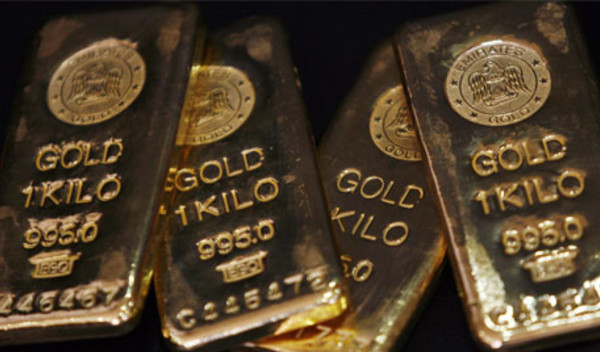

What a difference a year has made for gold.
In October 2018 the metal was in the doldrums.
Gold was trading below $1,200(£912)/oz on October 10 2018.
Futures market positioning in gold – an indication of market sentiment towards the metal – had fallen to its lowest level since 2001.

The market had shunned the metal, known for its defensive qualities, while equity markets were roaring.
Today (October 10 2019) however, gold is trading above $1,500/oz. Futures market positioning in the metal has recently reached an all-time high.
The rise of gold
So what has changed? Market perception of risks, both geopolitical and financial, have been revised upward.
Key points
- Gold is back in fashion, as other defensive assets are offering negative yields
- In times of stress, gold has a positive correlation with the US dollar
- Gold can be bought in bars, coins or ETPs
The ongoing trade war, primarily between the US and China, appears to be driving fears of a global economic slowdown.
Manufacturing, the sector most affected by a contraction in traded goods, is declining fast across the globe. Gold, playing true to its historically defensive traits has rallied as a result.
The policy response from global central banks to the economic slowdown has also aided gold’s ascent.
Gold typically has an inverse relationship with interest rates.
As policy rates across the world fall, gold prices rise.
In fact, a low-rate environment has driven more than $17tn of debt (mainly sovereign bonds) to become negatively yielding.
Gold, once criticised for not yielding anything, appears far better than other ‘anti-fragile’ assets that are negatively yielding.
In times of economic stress, many investors reach for safe haven assets and currencies.
Among this group of haven currencies are the US dollar, Swiss franc and Japanese yen. Gold is seen a pseudo-currency (also an historically safe-haven asset).
Usually gold (when priced in US dollars) has an inverse relationship with the US dollar.
But in times of stress, when they are both in demand, they often have a positive correlation. That describes the situation in the past few months.
Non-US investors who have bought gold in dollars have received a double boost: gold prices have risen and the dollar has appreciated.
Our modelling work indicates that gold has risen by more than what can be explained by just currency and interest rate movement.
The sentiment factor – that is, what we glean from the futures market positioning – is very important at this stage.
It indicates the market is fearful of an adverse fall-out.
It is not surprising given how little policy space central banks have today with interest rates already having hit the zero bound in many places.
Comments from the European Central Bank seem to advocate higher fiscal spending as the monetary authority appears to be running out of policy space.
Some investors are likely fearing that an age of experimental policymaking is ahead of us, once again seeking the comfort blanket of gold.
With gold clearly back in vogue, how best to access it? Gold can be bought as an investment in physical form – through coins or bars.
Coins and small bars tend to trade at a premium.
Setting the standard
When looking at larger bars, the London Bullion Markets Association Good Delivery sets the standard for weight and purity of most of the traded physical gold.
The LBMA maintains and publishes “Good Delivery” lists that establish a set of criteria that a refiner and its bullion must satisfy before being accepted for trading.
According to the Good Delivery Rules of the LBMA, a gold bar must have a minimum fineness of 99.5 per cent and a weight of approximately 400 troy ounces or 12.5 kilograms. At today’s prices such a bar would cost around $600,000.
Futures markets also provide access to gold.
Gold futures are standardised, exchange-traded contracts in which the contract buyer agrees to take delivery, from the seller, of a specific quantity of gold at a predetermined price on a future delivery date. NYMEX Gold futures prices are traded in lot sizes of 100 troy ounces.
Through the system of margin, futures market positions offer leverage to the investor. But to access the futures market, the investor must be a member of the exchange or have a relationship with a broker who is a member.
Gold exchange-traded products provide investors with exposure to the price performance of spot gold bullion.
The most popular gold ETPs are physical gold products that are backed by gold bullion held in secure vaults.
Investors have favoured gold ETPs as they offer a cost-efficient and a secure way to participate in the gold bullion market without having to take physical delivery of the gold itself.
These products offer many of the advantages of holding physical bullion directly without the investor having the hassle of vaulting and insuring (these are incorporated into the management cost of the product).
These products do not have the same price premium as coins and small bars, but investors that buy these securities gain metal entitlement to LBMA bars held by the issuer (and so investors do not have to buy a 400oz bar themselves to access the advantages of investing in bullion).
It is important that investors understand the differences between individual gold ETPs to ensure the product they are considering investing in will intrinsically meet their investment goals.
We believe that the robustness of the structures and processes that govern physically backed gold ETPs are key to selecting a vehicle that holds physical gold.
It is beyond the scope of this article to list all the considerations, but we believe that robust security of the gold, pricing transparency, trading liquidity and spreads are key aspects to consider.
After all, gold is a port of call in times of market anxiety, and so a gold ETP should remain structurally robust in times of financial market stress.
Nitesh Shah is director of research at WisdomTree



